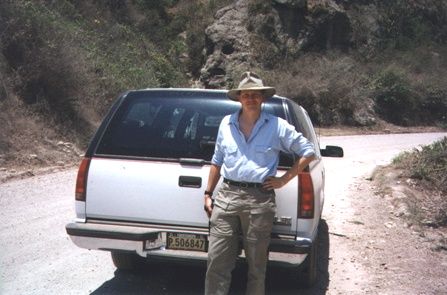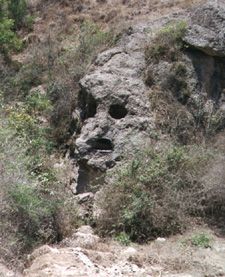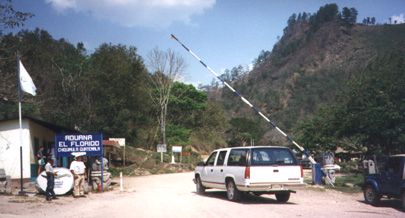05 APRIL (Saturday)
First thing in the morning, we checked out of the hotel and began our drive to Honduras.
Within a block or two of the hotel we stopped at a local supermarket to stock up on
provisions. Water and other items are definitely cheaper away from the hotel, where prices
are inflated for the tourists. We bought enough bottled water to last a few days (a couple
small carrying bottles and several gallon jugs), and bought some bread and other munchies
to serve as a makeshift breakfast that we could eat on the road (not knowing for sure how
long the trip would take, we didn't want to waste any time). Then, it was off on the great
adventure....
Sue drove while I navigated and took the occasional video shot of things that we
passed. We were glad when we got out of the city traffic and onto the more open and serene
rural highway. We stopped at one point for gas, directions, and a restroom break. This
became our first introduction to rural Central American restrooms. No running water, no
toilet paper, no lock on the door, and you had to reach through a hole in the wall to grab
a wire to pull so that the toilet would flush. How quaint.
We passed a fire that had been set by the local farmers to clear their land, in the
centuries-old tradition. We saw the thatched mud homes of some of the poorer local
residents, looking exactly like the ones built by their Mayan predecessors some 1500 years
previous. We saw the pistachios, fresh fruit, and other items sold car-to-car by the poor,
who took advantage of our lane being stopped for ten minutes in a mountainous road
construction area. Seeing the local color and culture was wonderful, though we probably
stuck out like a sore thumb.
Following the major highways was very easy, although tracking our progress was a little
harder, as not all of the towns could be identified as we drove thru them. We made the
turn towards the El Florido border crossing, feeling lucky that we'd managed to spot the
small sign that pointed to the road that would lead us out of town. The road was now no
longer paved, and we felt like we were leaving civilization behind. While winding through
the hills we came across a large outcropping of rock in the hill next to the road. It had
holes (about a 18 inches across) in it that made it look like it had eyes, a nose, and
mouth. We couldn't tell if the holes were natural or man-made, but someone had added white
teeth to the mouth, and there were flowers left nearby. Was it an old idol?


Here I am with the trusty Suburban on the (dirt) road in Guatemala on the way to the
border crossing into Honduras. In the background you can see the stone face carved into
the rocky hillside, and the second picture shows it in more detail. The jagged white teeth
in the bottom of the mouth don't show well in this scan.
The road became rough at some points, and we had to cross about a half-dozen small
streams during the journey. Thank goodness we had the Suburban, and that this was the end
of the dry season. I wondered what the "streams" would look like during the wet
season. We saw one or two other vehicles heading the other direction during the 50
kilometers of dirt road that led to El Florido. One happened to pass us right as we got to
the largest of the streams. We watched him pick his path through the water, and figured
that if he could get through without sinking out of sight, so could we.
We eventually came to a small town, the last Guatemalan town before El Florido. There
was virtually no way to tell what direction or street we needed to go in order to get to
Honduras. We got lost once or twice, ended up on some dead-end streets, and drove around
and through some very poor neighborhoods in our efforts to get back on track. The locals
looked at us as if to say "what are you doing here?". I'm sure they don't get
many Suburbans with white tourists passing through their part of town very often.
After stopping for directions (a semi-successful effort) and the purchase of a pen and
some fresh tortillas, we eventually found the road that led out of town. Unfortunately, it
forked off in two different directions, with no sign to guide us. We picked what we
thought was the correct direction, but after driving for awhile we came across an area
that looked too familiar.... we were heading back to Guatemala on the road we had taken
into the last town! We found a spot to turn around, got back to the forked road, and
headed off in the correct direction. Upon eventually reaching the border crossing at El
Florido, we congratulated ourselves, parked the vehicle, and got out to look around.
There was a building to our right that held nothing of interest, especially when we
learned that its bathrooms were out of order. On the left was the official Guatemalan
building that was just long enough to hold the three offices for the border crossing
personnel. Not far away was the long pole across the road that served as the gate into
Honduras. A few feet beyond that began a similar building for the Honduran border
officials. I was able to use some key Spanish phrases to convince someone to let me borrow
their outhouse that was up the hill, which was a welcome respite after the bumpy drive.
We went into the Guatemalan offices, and went through three sets of rooms and people
(immigration/customs, vehicle documentation, and the police). Each department had to
review our passports or other paperwork, receive a small fee, and had to give their
official stamp onto a 2x6 inch piece of paper. This was the paper that allowed the border
guard to admit the two of us through the international "gate". The paper was
given to me, and other than a brief check of Sue's passport, they dealt mostly with me, as
if I were the only one of importance. We wrote it off to the "machismo" factor
that we thought was stereotypical of the Latin American world.
After completing the process, we were rather proud of how things were going. The one to
two hour ordeal that we were expecting had only taken about ten minutes. I guess the
guidebooks we'd read had been written during the Guatemalan civil war, and the borders
were more closely guarded then. The official paper allowing us to take the rent-a-car over
the border (which we made sure that we got in Guatemala City) was just what we needed to
get through the one stage of the process, and it now was hung upon the wall of the
vehicular office, awaiting our return in a few days. Using our basic Spanish we had
managed to convey the concept to everyone that we were only going as far into Honduras as
Copan, and that we would return in a few days. It was all going pretty well.
We then went outside where a man and his friend (who looked like any other pair of
ordinary men in this part of the world) asked us if we needed to have money changed. We
both exchanged some of our Guatemalan quetzals for the Honduran dollars, watching as he
pulled a large wad of bills from his pocket to make the exchange. The exchange rate was
fair, and we figured that this was as close to a bank as we were likely to find in this
rather empty location.
We were not the only non-Latinos in the area, as there was also a pair of European
college students there, who, with their backpacks (no vehicle) were conversing nearby. I
had the impression that something was holding up their progress, but didn't inquire as to
what (or even if they spoke English).
We showed our stamped slip to the gate guard, and proceeded to the Honduran offices.
again, all went well, until we reached a station where a young man in an Army-type uniform
asked for our vehicle's paperwork. He wanted to see the rent-a-car company's permission
letter, in order to allow our vehicle to proceed. We tried our best to make him understand
that the letter was now in the Guatemalan customs office just a few hundred feet away, and
that we no longer had it, but he insisted on the paperwork. In desperation we went to the
Suburban and retrieved the vehicle's registration, rent-a-car paperwork, and any other
papers we could find. We handed him the papers (which coincidentally, had official stamps
upon them), and watched as he went through them. Running his finger down the page he would
say "hmmm...." or other such sounds, and eventually took our second gate
permission slip and put on his department's seal. I was surprised that he had accepted our
"paperwork", but I didn't ask any questions. Sue told me later that she was
trying not to laugh, as she had noticed that he was holding the page upside down! He
couldn't read.... but he didn't let that stop him from doing his entrusted duties, and so
we all played our part, and in the end it all worked out.
With our completed slip in hand, we went back to the gate guard, handed him the
Honduran stamped slip, and waiting for them to unlock the chain and raise the gate pole.
As we drove across into Honduras we smiled in satisfaction, noting that the entire stop
had only taken about twenty minutes.

Driving the Suburban over the El Florido border checkpoint into Honduras. Sue stayed
behind just long enough to snap the photo, then met me on the other side of the gate,
where we continued our journey.
Shortly after we crossed over into Honduras the road became paved again, and we drove
the last twelve kilometers to the town of Copan easily. On the outskirts of town we
stopped to look at the local cemetery, which was adorned with flowers and pieces of
brightly colored cloth. Using our map of the city from one of the guide books, we
navigated down the major streets (which were small and cramped from an American's
point-of-view), and eventually found the Hotel Marina Copan, just off the city square.
Parking was at a premium, but we found a space to park in the lot behind the hotel,
checked in, stowed our stuff in the room, and headed off into town on foot.
It was a little after 4:30pm, and we went directly to the town's Mayan museum that is
right on the city square. They were going to close soon, so we hurried to pay admissions,
buy postcards and a souvenir book, and rush through the small museum snapping photos and
taking videos the whole way. As we were getting near the end they were turning out the
lights on us, but we made it through without missing too much.
We visited some of the local shops looking for souvenirs or other items of interest,
occasionally fending off local children on the streets who tried to sell us (10"
high) stone replicas of the Copan stelae. We soaked up the music and other sounds in the
town square, then headed back to the hotel for some relaxing time in the pool before
dinner. We met an American who had come down on a bus after flying into the Honduran
capital (the main way tourists get to Copan), and traded stories. A light rain fell
briefly, but it soon went away. We decided we were getting hungry, and went for the
convenience of the hotel's on-premises restaurant. We were the only ones there (besides
the hostess), so we were well taken care of. Part way through the meal a few other people
arrived, so it wasn't too quiet. The meal was excellent, and during our trip we found that
we could usually order the more expensive dishes and not have to worry about the cost, as
food and room rates were all very reasonable.
Back in the room we wrote a few postcards and turned in early, so that
we could get up early and go to the ruins first thing in the morning. One thing about
postcards.... we bought them wherever we went (two of each good design, so that each of us
would have a photo memoir in case our photos didn't turn out), as well as a few to mail
while we were there. In all cases, however, we finished our two-week trip and were back at
home before any of our friends received their cards.